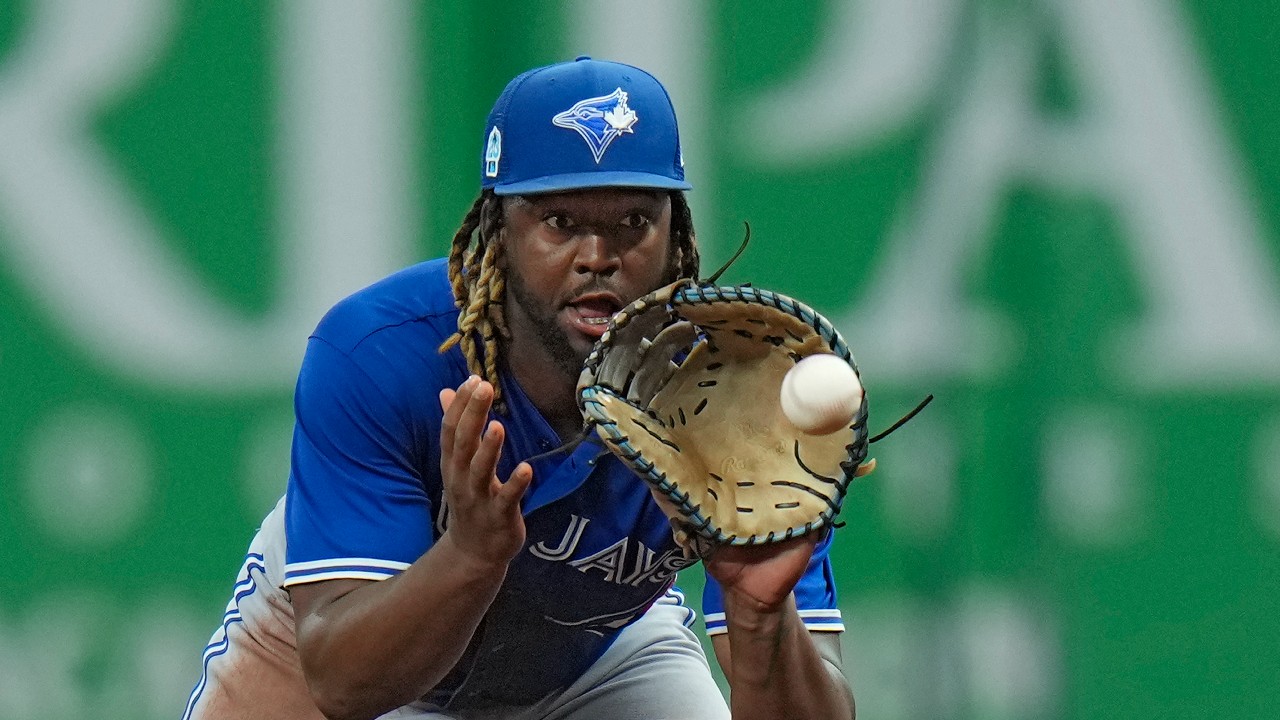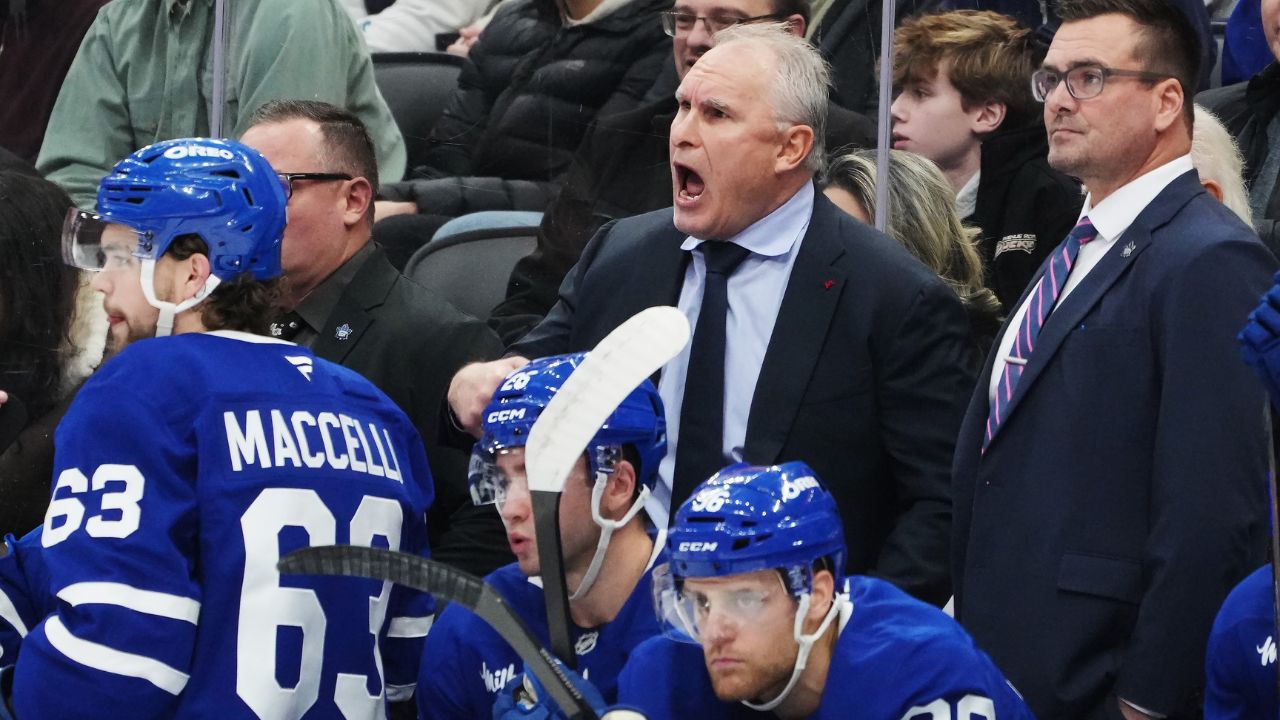
DUNEDIN, Fla. — Rainer Nunez was working on some things with Santiago Espinal in the batting cages last week when Guillermo Martinez, the Toronto Blue Jays hitting coach, stopped by with news.
“Hey, man — you’re starting against the Yankees tomorrow,” Martinez told Nunez, a 22-year-old prospect who reached high-A Vancouver last season. “And they’ve got Cole going.”
That would be Gerrit Cole — MLB’s 2022 strikeout leader, multiple time Cy Young finalist, etc. etc. You know who he is. Of course, Nunez did, too. He’d never faced a pitcher anywhere near Cole’s level since the Blue Jays signed him out of the Dominican Republic in 2017. You don’t see many fastball-slider mixes like Cole’s in A-ball. So, Nunez asked Espinal and Martinez how he should approach the challenge.
Easy. Stay up the middle, they told him. That’s exactly what Espinal and Nunez were working on that day — keeping their bats on plane through the zone against premium velocity and movement thrown inside, and not pulling those pitches to their lefts. Cole’s really good, Espinal admitted. But not anything Nunez couldn’t handle. You’ve got all the bat speed and pop you need. Just let the ball travel and trust it.
“I reminded him in BP before the game, like, ‘Hey, you don’t have to pull anything. Trust your swing. Trust your power. Just stay back, see the ball, and react,’” Espinal says. “And then dude goes up there, first-pitch slider — boom. Right-centre. Frigging drilled it.”
That first-pitch Cole slider came in quick at 89 m.p.h. And it left even quicker, jumping off Nunez’s bat at 106 m.p.h. and sailing 407 feet over the right-centre field wall. The game wasn’t broadcast, so the best visual we can offer is the following shaky smartphone video from the stands — but even that picked up the different sound Nunez’s bat makes when he connects:
“You could see it in BP, like, ‘Dang, this guy’s got pop.’ But then to go do it in the game? First pitch? That’s crazy,” Espinal says. “He’s got that kind of power where he can do whatever he wants with the ball. Left-centre, right-centre, wherever. I wish I had that pop.”
A lot of players wish they had that pop. Just about everyone in the Blue Jays organization. Ask club developers who has the best raw power in the entire system and they return the same three names. Vladimir Guerrero Jr., obviously. Peyton Williams, a six-foot-five, 255-pound first baseman who put up 61 extra-base hits over his 107-game college career. And Nunez.
The hulking, right-handed hitting first baseman wasn’t even supposed to be at major-league spring training this year, but impressed so thoroughly during early-camp opportunities filling in for Guerrero, who was sidelined for 11 days with an injury, and Brandon Belt, who’s coming off knee surgery, that the Blue Jays gave him an official invite and a locker less than two weeks after games began.
With the regular season looming, and Guerrero and Belt both back in action, Nunez has returned to the minor-league side of camp. But the power he displayed is still causing reverberations. He holds five of the 20 hardest-hit tracked balls to come off a Blue Jays bat in major-league games so far — including the hardest one of all, this 114-m.p.h. walk-off:
“Yeah, that was a missile,” Martinez says. “You forget that he’s 22. That’s how good he’s looked. I remember seeing him when he was 17 years old in the Dominican — completely different type of hitter. He was just your typical young kid, hacking, lot of swing and miss, no approach. But now he’s got a plan. You can see that there’s an approach now at the plate. It’s really impressive how he’s adjusted. He’s continued to progress every single year.”
Nunez is from Los Mulos, a small neighbourhood near La Romana on the Dominican Republic’s east coast. He grew up playing baseball in the street with a sawed-off broomstick and a ball fashioned out of rolled-up socks. There was always a passion for the game — he idolized Adrian Beltre and Miguel Cabrera. But he never saw himself playing it professionally.
“Baseball was just a part of my day,” Nunez says through club interpreter Hector Lebron. “I’d wake up, I’d go to school — and right after school, I’d run home to play baseball in the street. I was just in love with it.”
When he was nine, Nunez joined a small baseball league near his hometown named El Rescate, where a scout from El Niche Academy saw him play and recruited him to live and train out of the academy’s Santo Domingo facility. Getting exposed to a higher level of competition, not to mention baseball-specific training and conditioning routines, was eye-opening for a kid used to swinging broom handles.
“At Niche, their goal was to get as many players signed as possible every year. They’re winners. I remember a year when out of 15 players at the academy, 13 signed; if there were 20, 18 of them signed.,” Nunez says. “I saw that right away when I got into their environment and that gave me motivation. I said, ‘I’m not going to be the only one left here.’ So, I made getting signed my focus. I started working very, very hard. Because I wanted to achieve my goal.”
It’s true — El Niche develops a lot of talent that ends up making its way into affiliated ball in North America. Perhaps you’ve heard of a young outfielder by the name of Juan Soto. He cut his teeth at Niche as a raw 15-year-old long before he became one of the best hitters on the planet.
Toronto’s signed a slew of players out of Niche over the years, including Otto Lopez, Steward Berroa, Cristian Feliz, and Railen Tejada. Lopez describes the academy’s culture — forged by its owner, Cristian Batista — as “super competitive.”
“It was all baseball, all day. Training, lifting, conditioning. From early in the morning all the way through the afternoon,” Lopez says. “It’s good for us because it makes you know the game better. You get to know your swing really well. It’s just a bunch of young dudes trying to make it. It’s really fun.”
Blue Jays scouts are constantly monitoring the teenagers coming out of Niche, which brought them to Santo Domingo in 2016 to watch a workout featuring then 14-year-old Robert Puason, who ultimately signed with the Oakland Athletics for a startling $5.1 million in 2019, and Nunez, who was a shortstop at the time.
Yes, they all start as shortstops. And Nunez was a lean, six-foot, 150-pound one at that. Which was after a growth spurt. When Nunez arrived at El Niche, he was closer to five-foot-nine and 135 pounds. That’s when Batista gave him the nickname that still follows him to this day — “Mosquito.”
“When I saw him, the thing that stood out to me was the defensive skills. He moved well at short. He made plays. He threw well. He had actions,” says Andrew Tinnish, Toronto’s vice president of international scouting. “I thought there was an ability to hit. But an average power profile. He was so wiry. At 16, you figure he could sprout up one more time, gain some strength. But I did not think the body was going to look like this.”
This is the six-foot-four, 240-pound “Mosquito” today. He’s the absolute unit with the chain on in the photo above. Safe to say he’s not a shortstop anymore. Probably not even a third baseman. Nunez has grown so big, so fast that he’s been limited to playing first base since the beginning of 2021. At one point, he blew all the way up to 260 pounds and had to trim some weight.
It’s the result of Nunez’s diligent focus on strength programming and nutrition since the Blue Jays signed him to a $350,000 bonus in 2017. Particularly as he moved to North America at 18 and began climbing Toronto’s affiliated system after spending a summer playing out of the club’s Dominican academy.
Results-wise, those early years were unimpressive. But in 2021, Nunez walked nearly as often as he struck out in the Florida Complex League and started flashing some of those 110-m.p.h. exit velocities that get development departments buzzing. Then he opened 2022 with nine homers in his first 28 A-ball games, ultimately posting an .810 OPS at the level — Nunez put multiple balls in play up over 114 m.p.h. — before earning a high-A promotion in August.
After finishing his season hitting .321/.379/.491 over 28 games with Vancouver, Nunez was sent to the Dominican Winter League — LIDOM — for more plate appearances and to continue honing some adjustments the Blue Jays were challenging him to make. Nunez’s new-found power was speaking for itself, but discipline was an issue — he was trying to hit everything.
Toronto developers wanted Nunez to refine his plate approach against advanced pitching and work on making better swing decisions. They figured he’d get a couple weeks of LIDOM games — where the average age is seven years his senior — and then shut things down for the year.
Only one problem. After those two weeks, Nunez’s LIDOM team — Estrellas Orientales — said he wasn’t allowed to leave. He was too valuable. Nunez kept playing with Estrellas through their entire schedule, leading LIDOM in home runs and winning its rookie of the year award.
“That’s impressive. I can tell you — hitting like that in winter ball, that’s tough to do,” says Lopez, who’s played in LIDOM each of the last four off-seasons. “It’s the pitching — that’s the toughest part. You’ll see a guy who’s throwing stuff from, like, 82 to 89. All these crazy breaking pitches you’ve never seen before. You don’t know where this guy’s coming from. And then in the seventh inning, they bring in some guy throwing 100. And you don’t have any information on these guys because they’ve been playing in Mexico and all these other leagues you’ve never heard of.
“At the plate, you just don’t know what to do. Being able to hit a guy who you’ve never faced, it’s tough. And how many home runs did he hit in his rookie year? Seven? Nobody can hit more than five there. That’s crazy.”
Ultimately, Nunez hit .263/.303/.445 with 11 extra-base hits over 145 plate appearances with Estrellas. Putting up those numbers in that environment at 21 is certainly one way to get noticed. But what impressed the Blue Jays most over the winter was the way Nunez continued working on his body while playing so often.
“That’s one of the challenges of playing winter ball. The off-season’s a time for getting stronger, working on your swing, things like that. It’s really hard to do those things while you’re playing winter ball,” Tinnish says. “But he stayed on his program while playing games every night. He remained really, really focused on doing both of those things.”
Two months later, Nunez rolled into Dunedin and continued mashing baseballs. Through only 26 plate appearances this spring, Nunez put eight balls in play with exit velocities over 105 m.p.h. That 114-m.p.h. walk-off is the 11th-hardest tracked ball in play across both Grapefruit and Cactus Leagues this spring. Only 42 big-leaguers hit a ball that hard in 2022.
Of course, the separator for Nunez, as it’s been for countless players with massive power like his, will be strike-zone management and swing decisions. That’s how you survive in the big leagues. Nunez’s strikeout and walk rates went in the wrong directions in 2022 as he moved up minor-league levels. His biggest challenge going forward will be reversing that.
But Nunez has been doing the unexpected for a while. It wasn’t so long ago he was swinging a broom handle at balled-up socks in the streets of Los Mulos. Now he’s taking Gerrit Cole deep to right-centre. If you saw him up close five years ago, you’d understand why they called him Mosquito. Now, he’s a mountain. Having seen some of the balls Guerrero’s crushed this spring, you wouldn’t bet there’s a 22-year-old kid in camp who’s hit one harder.
“I enjoy challenges. I enjoy just being here,” Nunez says. “That’s what I think about at the plate. Just go in there and enjoy it. Enjoy the at-bat. Don’t worry about who you’re facing, the hitters that were ahead of you, if they didn’t look good at all. Don’t worry about that. Just go in there, have fun, and see what you can do.”







